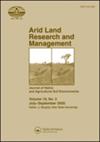利用GMP DPR数据分析伊朗沙漠冬季降雨的时空格局
IF 1.6
4区 农林科学
Q3 ENVIRONMENTAL SCIENCES
引用次数: 0
摘要
卢特沙漠和卡维尔沙漠被称为世界上最温暖的沙漠,但由于气象站不足,其降雨量和综合水量尚不清楚。全球降水测量(GPM)任务卫星上的双频降水雷达(DPR)为研究2015-2020年冬季(12月至3月)两个沙漠的降雨量和垂直综合液态水含量(LWC)和综合非液体(冰)水含量(IWC)提供了统计和距离分析的机会。结果表明,GPM DPR与台站数据具有较好的相似性,Pearson相关系数为0.81。3月对降雨量的贡献最大,两个沙漠的降雨量贡献都在37%左右。3月也是雨季贡献最大的月份,在卢特沙漠和卡维尔沙漠分别约占41.4%和37.6%。LWC在Lut沙漠中数量最多,而IWC在Kavir沙漠中数量最多。距离分析表明,卢特沙漠降水呈现自西向东显著增加的趋势。海拔高度对降水分布影响不大,但降水受大气驱动大尺度参数的影响较大。本文章由计算机程序翻译,如有差异,请以英文原文为准。
Analysing spatio-temporal patterns in wintertime rainfall across Iran’s deserts using GMP DPR data
Abstract Although known as the warmest deserts of the world, rainfall and integrated water of Lut and Kavir Deserts is still unknown due to insufficient weather stations. The Dual-Frequency Precipitation Radar (DPR) onboard the Global Precipitation Measurement (GPM) mission satellite created an opportunity for use to study the rainfall and vertically integrated liquid water content (LWC) and integrated non-liquid (ice) water content (IWC) using statistical and distance analyses over the two deserts during winter months (December to March) of 2015–2020. The results showed good similarity between the GPM DPR and station data with a Pearson correlation coefficient of 0.81. March has the highest contribution in rain amount, which is about 37% in both deserts. March also has the largest contribution of the rainy days, being about 41.4 and 37.6% in the Lut and Kavir Deserts, respectively. LWC has the highest amount in the Lut Desert, while IWC is the largest in the Kavir Desert. Distance analysis showed that there is a significant increasing trend of rainfall from west to east in the Lut Desert. Elevation does not affect rainfall distribution strongly, but rainfall is highly influenced by the atmospheric-driven large-scale parameters.
求助全文
通过发布文献求助,成功后即可免费获取论文全文。
去求助
来源期刊

Arid Land Research and Management
环境科学-环境科学
CiteScore
3.80
自引率
7.10%
发文量
23
审稿时长
9 months
期刊介绍:
Arid Land Research and Management, a cooperating journal of the International Union of Soil Sciences , is a common outlet and a valuable source of information for fundamental and applied research on soils affected by aridity. This journal covers land ecology, including flora and fauna, as well as soil chemistry, biology, physics, and other edaphic aspects. The journal emphasizes recovery of degraded lands and practical, appropriate uses of soils. Reports of biotechnological applications to land use and recovery are included. Full papers and short notes, as well as review articles and book and meeting reviews are published.
 求助内容:
求助内容: 应助结果提醒方式:
应助结果提醒方式:


